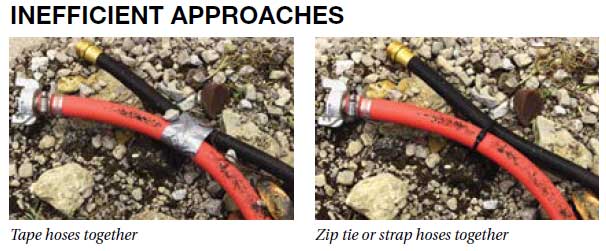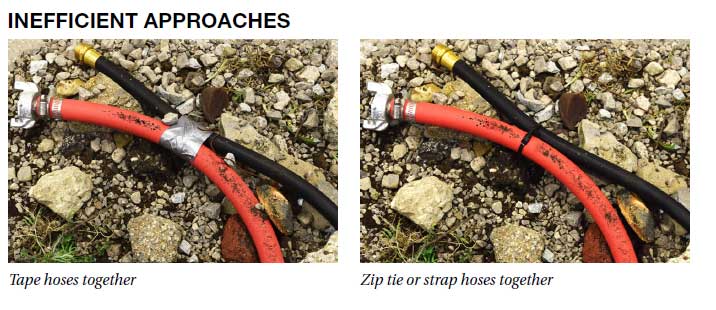Twin Hammer Hose

Javascript DHTML Drop Down Menu Powered by dhtml-menu-builder.com
|
Twinhammer™ Bonded Air/Water Jackhammer Hose System
Series 7084

|
Wet Method Hose System to Comply with the OSHA Respirable Crystalline Silica (RCS) Standard
Parker Series 7084 Twinhammer Hose is the first factory-assembled dual hose system that delivers both air and water
in a single, unitized configuration for silica dust suppression in pneumatic jackhammer applications. Twinhammer Hose is a safe and efficient way to comply with the OSHA standard.The new twin line hose system:
- Transfers air to power heavy duty pneumatic jackhammers/breakers?
- Transfers water to suppress silica dust produced by tool operation
- Helps create a safer and more efficient work environment
Twinhammer hose assemblies feature durable abrasion resistant and chemically bonded lines for easy handling.
The design eliminates the need for intrusive clamps, straps, tape or zip ties used to cobble together a
makeshift harness for independent air and water hoses. The assemblies? incorporate universal end styles for quick connection/disconnection to the air supply, and rust resistant brass male NPT couplings for easy attachment to the water supply and spray nozzle.
Twinhammer Hose Value
Easy handling and installation Bonded lines are permanently and continuously joined.
No improvised field attachment or
maintenance of clamps, straps or zip ties that loosen, get snagged, kink hose and become potential safety hazards
Quick identification via color-coded hoses
Red 3/4" 300 psi hose for air
Blue 3/8" 300 psi hose for water
spray/dust suppression Secure, maintenance-free connections with permanent crimp couplings
|
Series 7084 Twinhammer™
Air/Water Hose Assemblies
Tube: Black EPDM
Reinforcement: Multiple textile plies
Cover: Air Hose: Red EPDM Water Hose: Blue EPDM
Temp Range: 40°F to +212°F (-40°C to +100°C)
Brand Method:Air Hose: White ink Water Hose: No brand
Brand Example: PARKER SERIES 7084 300 PSI MAX WP
MADE IN USA (DATE CODE)
Applications: Wet method dust suppression hose system
for pneumatic jackhammers
Couplings: Air Hose: Crimped carbon steel universal each end Water Hose: Crimped brass 3/8" x 3/8" rigid male NPT each end
Packaging: Coiled and tied, no center disc; cartons
|
Jackhammer Hose Spray Kit
The Parker jackhammer hose spray kit provides an engineered transfer of water from the supply hose to the
jackhammer bit. The kit is easy and convenient to install and provides efficient and consistent water
angle, distance, flow and spray pattern for effective silica dust control.The kit can be used as part of an OSHA-compliant wet method hose system for silica dust suppression.
The kit includes the hardware and attachment components to apply to many models and generations of jackhammers*:
The kit includes the hardware and attachment components to apply
to many models and generations of jackhammers*:
•Couplings/connectors
•Jumper hose
•Shims n Water nozzle
•Straps
•Thread tape
•Jumper hose n Water valve
•Shims n Water nozzle
•Straps n Installation instructions.
* Twinhammer Hose Assembly ordered separately
|
|
Part
Number
|
Pkg
|
Individual Carton
Dimensions
(in)
|
Pkg
Weight
(lbs/kit)
|
Std
Pack
Qty
|
Stock
Status
**
|
7084JHT75-KIT
|
Carton
|
10" x 10" x 3"
|
4
|
3
|
Y
|
|
|
** Stock Status:“Y” indicates stocked item; “N” indicates non–stocked item.
Stock status subject to change. Contact Parker Customer Service.
Packaging:Unit of measure = 1 kit, individually boxed (3 kits per master carton).
|
New OSHA Standard for Construction Industry

Respirable Crystalline Silica (RCS) Standard for Jackhammer Operation
The U.S. Occupational Health and Safety Administration (OSHA) has created a new standard to address the problem of crystalline silica dust control associated with pneumatic jackhammer and breaker operation in the construction industry.The mandated compliance date of the new silica rule is September 23, 2017.
A wet method suppression system is a compliant solution suggested by industry practices and government
research. However, some hose-oriented deployment methods may be less efficient and less effective than others:
1) Manual Water Spraying
Using a Helper
A two-person job where a helper holds a water hose with a nozzle and sprays water at the locus of the jackhammer
tip and work object
Efficiency is diminished by requiring two workers
Effectiveness is reduced by inconsistent water angle,distance, flow and spray pattern
2) Independent and Unconnected Air and Water Hose Lines
Hoses typically use bands or clamps to attach fittings
Effectiveness is hampered by requiring the operator to
take time to regularly inspect the security of the fittings
Operator must maneuver independent hoses around debris, equipment and other obstacles to avoid hose damage and kinking
|
3) Independent and Mechanically Connected Air and Water Hose Lines
Hoses typically use bands or clamps to attach fittings n Apply zip ties, straps, tape or other
connectors at multiple intervals along the lengths of both hoses to mechanically connect them
Effectiveness is hampered by requiring the jackhammer operator to devote attention,effort and time to:
– Select, procure and apply zip ties,straps or tape to hoses,– Regularly inspect the security
of the fittings and attachment components, and – Maneuver hoses whose zip ties, straps, tape and gaps between
the hoses may become snagged by debris, equipment and other obstacles at the jobsite, becoming potential safety hazards
|
Further Information Regarding the OSHA Standard
Jackhammer operation can release into the air a form of quartz known as respirable crystalline silica (RCS), a
substance found in bricks, clay,concrete, mortar, rock, stone and many other materials common to construction sites.
RCS can embed in the lungs of unprotected workers, causing serious, even debilitating health issues or death from conditions
such as lung cancer, chronic obstructive pulmonary disease(COPD), kidney disease or silicosis. Refer to OSHA's Final Rule to Protect Workers from Exposure to Respirable Crystalline Silica. For additional information visit OSHA's website and the Code of Federal Regulations (CFR).
The System Solution
Use the Parker Twinhammer Hose Assembly and Jackhammer Hose Spray Kit
Easy to install Efficient
EffectivePart of an OSHAcompliant design
|
New RCS Standard Implementation Timetable
Construction employers must comply with all requirements of the new OSHA RCS Standard by September 23, 2017, except for
certain laboratory sample analysis requirements and procedures in Appendix A of the Standard, which will be enforced beginning on June 23, 2018. That means that as of September 23, 2017, employers must either fully and properly implement Table 1* requirements
* See the Table as provided in the OSHA Standard. The Standard also is available in Parker's Summary Guide to the OSHA Rule (see below).
|
OSHA Penalties
OSHA’s maximum penalties, which were last adjusted in 1990, have increased by 81%. Going forward,the agency will continue to adjust its penalties for inflation each year based on the Consumer Price Index.
|
|
Type of Violation
|
Penalty
|
Serious
|
$12,675 per violation
|
|
Other-Than-Serious
|
$12,675 per violation
|
|
Posting Requirements
|
$12,675 per violation
|
|
Failure to Abate
|
$12,675 per day beyond the abatement date
|
|
Willful or Repeated
|
$126,749 per violation
|
|
Learn More
The Parker Summary Guide outlines the scope of the OSHA Rule and how it may affect a wide variety of
stakeholders in the construction industry.The Summary Guide and other detailed information about RCS and the new OSHA Standard areavailable from solutions.parker.com/twinhammer.
|
New OSHA Standard for Construction Industry

Respirable Crystalline Silica (RCS) Standard for Jackhammer Operation Is Effective September 23, 2017
The U.S. Occupational Health and Safety Administration (OSHA)has created a new standard to address the problem of crystalline silica dust control associated with pneumatic jackhammer and breaker operation in the construction industry.
The mandated compliance date of the new silica rule is September 23, 2017.A wet method suppression system is a compliant solution suggested by industry practices and government research. However, some hose-oriented deployment methods are more efficient and effective than others:
1) Manual Water Spraying Using a Helper
A two-person job using a dedicated helper holding a water hose with a nozzle, where the helper sprays water at the locus of the jackhammer tip and work object
• Efficiency is diminished by requiring two workers for one basic operation
• Effectiveness depends upon the attentiveness, experience and skill of the helper
2) Independent and Unconnected Air and Water Hose Lines
• Hoses typically use bands or clamps to attach fittings
• Attach hoses to a retrofitted jackhammer
• Effectiveness is hampered by requiring the jackhammer operator to devote attention, effort and time to regularly inspect the security of the fittings and attachment component
• Operator must also handle and maneuver independent hoses around debris, equipment and other obstacles to avoid hose damage and kinking
3) Independent and Mechanically Connected Air and Water Hose Lines
• Hoses typically use bands or clamps to attach fittings
• Apply zip ties, straps, tape or other connectors at multiple intervals along the lengths of both hoses to
mechanically connect them
• Attach hoses to a retrofitted jackhammer
• Effectiveness is hampered by requiring the jackhammer operator to devote attention, effort and time to:
–Select, procure and apply zip ties, straps or tape to hoses,
–Regularly inspect the security of the fittings and attachment components, and
–Handle and maneuver hoses whose zip ties, straps, tape and gaps between the hoses become snagged by debris, equipment and other obstacles at the jobsite, becoming potential safety hazards
Pre-spraying or wetting down the work area prior to jackhammer operation is ineffective and does not comply with the OSHA regulations.
Jackhammer operation can release into the air a form of quartz known as respirable crystalline silica (RCS), a substance found in bricks, clay, concrete, mortar, rock, stone and many other materials common to construction sites. RCS can embed in the lungs of unprotected workers,causing serious, even debilitating health issues or death from conditions such as lung cancer, chronic obstructive pulmonary disease (COPD), kidney disease or silicosis.
Refer to OSHA’s Final Rule to Protect Workers from Exposure to Respirable Crystalline Silica. For additional information visit OSHA’s website and the Code of Federal Regulations (CFR).
|
|